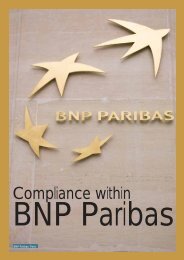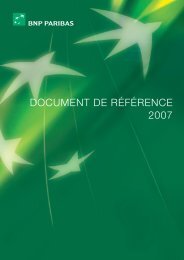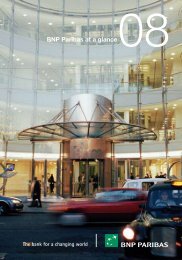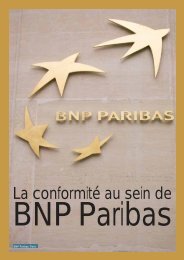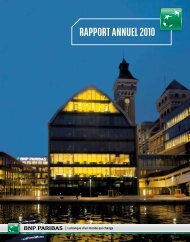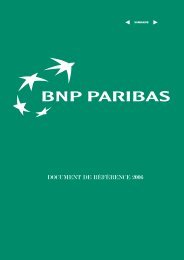2007 REGISTRATION DOCUMENT
2007 REGISTRATION DOCUMENT
2007 REGISTRATION DOCUMENT
- No tags were found...
Create successful ePaper yourself
Turn your PDF publications into a flip-book with our unique Google optimized e-Paper software.
5 NotesCONSOLIDATED FINANCIAL STATEMENTSto the financial s tatements p repared in accordance with I nternational Financial Reporting S tandards as adopted by the European Union1.c.3SecuritiesCategories of securitiesSecurities held by the Group are classified in one of three categories.Financial assets at fair value through profit or lossFinancial assets at fair value through profit or loss comprise:■ financial assets held for trading purposes;■ financial assets that the Group has opted, on initial recognition, torecognise and measure at fair value through profit or loss using thefair value option available under IAS 39. The conditions for applyingthe fair value option are set out in section 1.c.10.Securities in this category are measured at fair value at the balancesheet date. Transaction costs are directly posted in the profit and lossaccount. Changes in fair value (excluding accrued interest on fixedincomesecurities) are presented in the profit and loss account under“Net gain/loss on financial instruments at fair value through profit orloss”, along with dividends from variable-income securities and realisedgains and losses on disposal.Income earned on fixed-income securities classified in this category isshown under “Interest income” in the profit and loss account.Fair value incorporates an assessment of the counterparty risk on thesesecurities.Held-to-maturity financial assetsHeld-to-maturity financial assets are investments with fixed ordeterminable payments and fixed maturity that the Group has theintention and ability to hold until maturity. Hedges contracted to coverassets in this category against interest rate risk do not qualify for hedgeaccounting as defined in IAS 39.Assets in this category are accounted for at amortised cost using theeffective interest method, which builds in amortisation of premium anddiscount (corresponding to the difference between the purchase priceand redemption value of the asset) and incidental acquisition costs(where material). Income earned from this category of assets is includedin “Interest income” in the profit and loss account.Available-for-sale financial assetsAvailable-for-sale financial assets are fixed-income and variable-incomesecurities other than those classified as “fair value through profit or loss”or “held-to-maturity”.Assets included in the available-for-sale category are initially recordedat fair value plus transaction costs where material. At the balancesheet date, they are remeasured to fair value, with changes in fair value(excluding accrued interest) shown on a separate line in shareholders’equity, “Unrealised or deferred gains or losses”. On disposal, theseunrealised gains and losses are transferred from shareholders’ equityto the profit and loss account, where they are shown on the line “Netgain/loss on available-for-sale financial assets”.Income recognised using the effective interest method derived fromfixed-income available-for-sale securities is recorded in “Interest income”in the profit and loss account. Dividend income from variable-incomesecurities is recognised in “Net gain/loss on available-for-sale financialassets” when the Group’s right to receive payment is established.Repurchase agreements and securities lending/borrowingSecurities temporarily sold under repurchase agreements continue tobe recorded in the Group’s balance sheet in the category of securitiesto which they belong. The corresponding liability is recognised in theappropriate debt category in the balance sheet except in the case ofrepurchase agreements contracted for trading purposes, where thecorresponding liability is classified in “Financial liabilities at fair valuethrough profit or loss”.Securities temporarily acquired under reverse repurchase agreementsare not recognised in the Group’s balance sheet. The correspondingreceivable is recognised in “Loans and receivables” except in the caseof reverse repurchase agreements contracted for trading purposes, wherethe corresponding receivable is recognised in “Financial assets at fairvalue through profit or loss”.Securities lending transactions do not result in derecognition of theloaned securities, and securities borrowing transactions do not resultin recognition of the borrowed securities in the balance sheet, exceptin cases where the borrowed securities are subsequently sold by theGroup. In such cases, the obligation to deliver the borrowed securitieson maturity is recognised in the balance sheet under “Financial liabilitiesat fair value through profit or loss”.Date of recognition for securities transactionsSecurities classified as at fair value through profit or loss, held-tomaturityor available-for-sale financial assets are recognised at thetrade date.Regardless of their classification (at fair value through profit or loss, loansand receivables or debt), temporary sales of securities as well as sales ofborrowed securities are initially recognised at the settlement date.Securities transactions are carried on the balance sheet until the Group’srights to receive the related cash flows expire, or until the Group hastransferred substantially all the risks and rewards incident to ownershipof the securities.1.c.4< Contents >Foreign c urrency t ransactionsThe methods used to account for assets and liabilities relating to foreigncurrency transactions entered into by the Group, and to measure theforeign exchange risk arising on such transactions, depends uponwhether the asset or liability in question is classified as a monetary ora non-monetary item.1234567891011118<strong>2007</strong> Registration document - BNP PARIBAS



